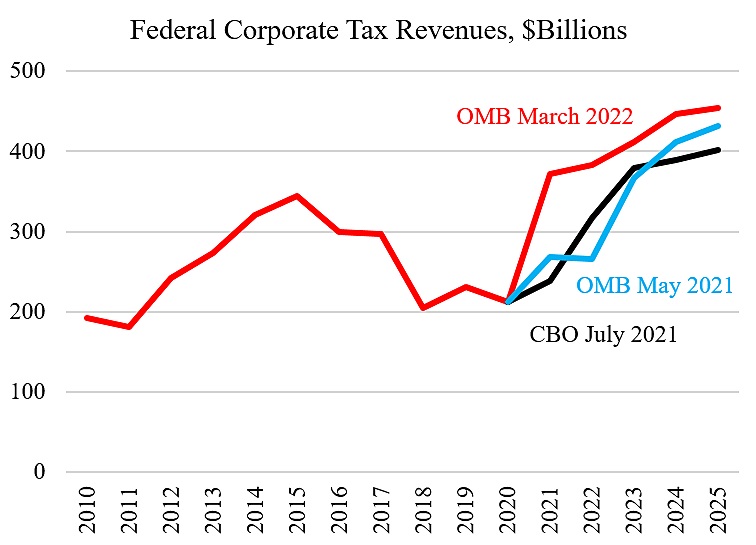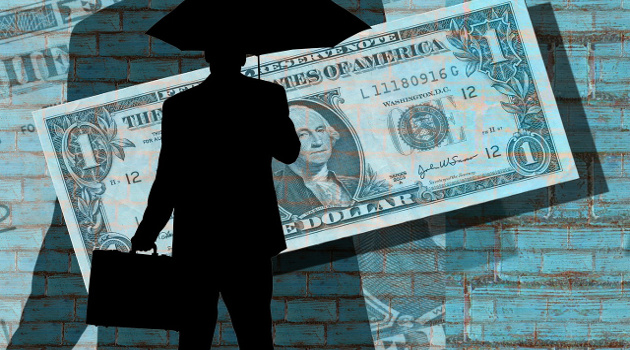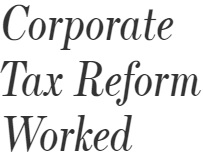During the debate about the Trump tax plan, proponents made three main arguments in favor of reducing the federal corporate tax rate from 35 percent to 21 percent.
- A lower rate would be good for workers, consumers, and shareholders.
- A lower rate would boost American competitiveness.
- A lower rate would produce some revenue feedback for the IRS.
The last item involves the “Laffer Curve,” which is a graphical representation of the non-linear relationship between tax rates and tax revenue.
Put in simple terms, entrepreneurs, investors, and business owners have more incentive to earn money when tax rates are modest.
High tax rates, by contrast, discourage productive behavior while also giving people a bigger incentive to find loopholes and other ways of avoiding tax.
This does not mean that lower tax rates produce more revenue, though that sometimes happens.
The main takeaway is the most modest observation that lower tax rates will lead to more taxable income, which means some revenue feedback.
In other words, tax cuts don’t lose as much revenue as predicted by simplistic models (and tax increases don’t generate as much revenue as predicted).
I’ve shared many, many real–world examples of this phenomenon.
And here’s another. Look at how corporate tax revenues in the United States are increasing at a faster rate than projected.

The chart comes from Chris Edwards, and he helpfully explains what has happened.
The revenue surge came as a surprise to government economists. The chart…compares the new Office of Management and Budget March 2022 baseline projections to prior baseline projections from the OMB in May 2021 and the Congressional Budget Office in July 2021. …congressional estimators figured that the government would lose an average $76 billion a year the first four years… Corporate tax revenues were down from 2018 to 2020, but then soared in 2021. Revenues in 2021 of $372 billion (with a 21 percent tax rate) are 25 percent higher than revenues in 2017 of $297 billion (with a 35 percent tax rate). …we’re learning that a lower corporate tax rate is consistent with strong corporate tax revenues. …lower rates…broaden bases automatically through reduced tax avoidance and higher economic activity. Other nations have learned the same lesson. Keeping the corporate tax rate low is a winner for businesses and workers, but it can also be a winner for government budgets.
The Wall Street Journal has a new editorial on this topic. Here are some relevant excerpts.
…the 2017 tax reform that cut corporate tax rates…has been a winner for the economy and federal tax coffers. …Corporate revenue was supposed to fall to historic lows as a share of the economy. Big business supposedly got a windfall and government was robbed. It hasn’t turned out that way. …the big news now is that more corporate tax revenue is flowing into the Treasury at record levels even with the lower rate. …In June 2017, before tax reform passed, CBO predicted corporate tax revenue of $383 billion in fiscal 2021. But in April 2018, after reform passed, CBO lowered its estimate to $327 billion.
So what happened in the real world?
Actual corporate income tax revenue in 2021 was $372 billion—nearly as much at a 21% rate as CBO expected at the 35% rate that was among the highest in the world. Fiscal 2022 is turning out to be even better for the Treasury. Corporate tax revenue for the first six months was up 22% from a year earlier to $127 billion. …What accounts for this windfall for Uncle Sam…? …the Occam’s razor policy answer is that corporate tax reform worked as its sponsors predicted: Lowering the rates while broadening the base by eliminating loopholes created incentives for more efficient investment decisions that paid off for shareholders, workers and the government.
Notice, by the way, that corporate tax revenues have increased faster than projected in both the 2017 forecast and the 2021 forecast.
All of which shows that I may have been insufficiently optimistic when I wrote about this issue last year.
P.S. The goal of tax policy (either in general or when looking at business taxation) is not to maximize revenue for politicians, but rather to maximize prosperity for people. Indeed, if better tax policy leads to a lot of revenue feedback, that’s an argument for further reductions in tax rates.
P.P.S. Both the IMF and OECD have research showing that lower corporate tax rates do not necessarily lead to lower corporate tax revenues.
———
Image credit: geralt | Pixabay License.





